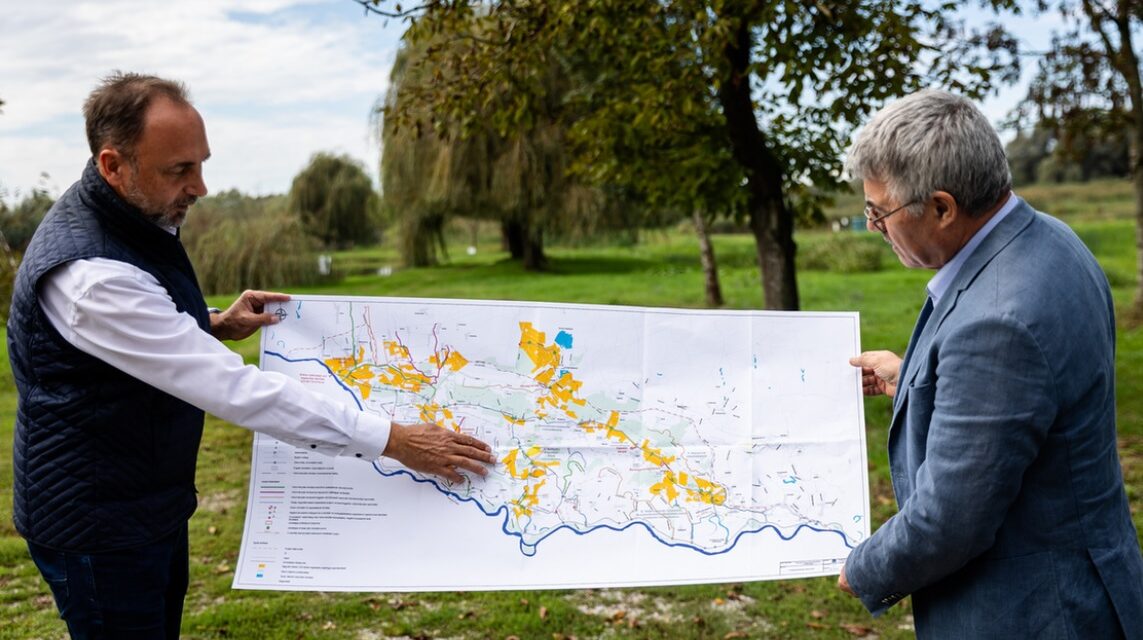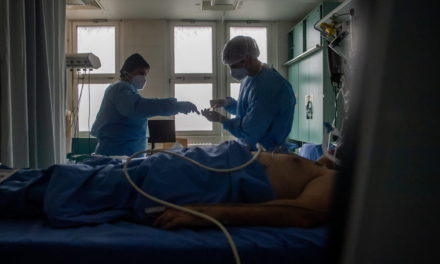Here is the Hungarian miracle drug, which is both a remedy for the murderous drought and the devastating flood.
The Ős-Dráva Program is a panacea that revitalized an area of 600 square kilometers in Ormánság, and which could be applied to the entire country. After all, it simultaneously remedies the devastating drought and floods as a result of drastic climate change, the latter of which we have just received a brutal dose of. Index on a report tour on the southern edge of the border, in Ormánság, which has been revitalized as a result of the program.
***
We are heading towards Sellye on an inferior road dotted with potholes that cannot even be called a highway with the greatest goodwill, which will soon turn into a dirt road. Sometimes we will bite our tongue, but the adversities are compensated by the idyllic landscape, which even human intervention could not destroy. Ormánság was once one of the rich regions of historical Hungary, with an ethnically Reformed Hungarian population.
The economic and social decline that continues to this day, accompanied by the atrophy of the living world, in the 19th and 20th centuries. It began at the turn of the 20th century, as can be seen from ethnographer Béla Gunda's monograph published in 1930:
"Moments of gathering farming, tree bark work, the direct adaptation of construction to the milieu, hemp and flax work immediately ceased or were replaced by new elements as soon as the landscape changed, the wild waters were drained and the gurus (wetlands) dried up. The change in the landscape not only resulted in the exchange of cultural forms, but also changed people; as soon as the water beds dried up, their song died away. Economic and social conditions only facilitated the agonizing work."
The river regulation caused a tragedy
So the decline was organically connected with the draining of wild waters, the regulation of the Drava bordering the landscape unit from the south, the cutting of bends, or meanders in a foreign word, the blocking and elimination of the natural channels connecting the backwaters with the river.
So, we are moving towards the center of the region, Sellye, in this ancient landscape that is still delightful in a fairy tale. My traveling companion was Tamás Nádasi, the president of Aquaprofit Zrt., and then Péter Udud, the general manager of the company, the business association that created the Ős-Dráva Program that started the rehabilitation of the area, joined us in Selly. The project, which could serve as a model to be followed for complete Hungarian water management, and whose motto says a lot: Together for the boost of Ormánság.

Photo: Péter Papajcsik/Index
The company was founded 28 years ago. In addition to many other serious commissions, in 2006 they started to develop their cherished project, the Ős-Dráva Program.
Presentation in Viktor Orbán's office
"Many years of planning work and a detailed survey of the terrain prepared the breakthrough. This happened on January 10, 2010, the date is burned into my memory, says Nádasi. - Then we finally managed to get into Viktor Orbán's office on Lendvai Street, the headquarters of Fidesz, the not-yet-ruling party at the time. We got half an hour from the former and later prime minister for the presentation, which was organized by the local representative of Fidesz, Zsolt Tiffán, but it piqued Orbán's interest so much that
the meeting lasted almost two hours and ended with this statement: Guys, this will be one of Fidesz's model projects!"
Why did they choose Ormánság as the scene of their historical experiment?
Péter Udud previously worked in the neighboring Pécs, at the South Transdanubian Water Administration, and Ormánság was, so to speak, his home field. By the way, the company also carried out research and studies for the rehabilitation of the sand ridge between the Danube and Tisza. (Shocking information: Germany now considers the sand ridge of Kiskunság a semi-desert area!)
Of course, God's mills grind slowly. It was already 2017 when they were commissioned to design and implement the complex project, which was finally completed in 2021.
The essence of the project is as follows: to restore the ancient, unfortunately XX. In the 19th century, a system of ditches, streams and canals was abolished, which ensured the water supply of the Ormánság region along the Dráva, when the term sustainable development was not even known in the literature.
"We built more than 25 kilometers of new riverbeds and reconstructed almost 100 kilometers of riverbeds, connecting watercourses in order to allow water to flow again through the connected riverbed network. About a hundred water management works were built and renewed in order to retain as much water as possible in the area and to manage the life-giving water within the boundaries of 44 settlements according to needs.
says Péter Udud.
This solves the flood and drought protection at the same time.
The old, magnificently functioning system had to be restored and must be restored, supplemented by water replacement and single-point water extraction from the Drava when there is very little rainfall.
Opened river branches, revived ecosystem
We soon arrived at Sellye, on the shores of a beautiful fishing lake and reservoir.
Our goal was to improve the infrastructural conditions of sustainable water management, as indicated by the construction of structures supporting water retention and water resource conservation. We had to implement, or more precisely, restore the water management system that takes ecological aspects into account
explains the CEO.
The basic objective of the project was to improve the water management possibilities of the region, to reduce drought in periods of abundant water and to promote the retention of water to protect wetlands. The company is proud of the fact that they performed not only the planning but also the implementation tasks, coordinated by the National Water Directorate General and the South Transdanubian Water Directorate General.
It is typical of the scale of the program that it covers 600 square kilometers, and among other things, two tributaries of the Dráva were opened and revitalized. By the way, in the past, the Drava flowed twenty kilometers further north than its current bed. Within the framework of the program, it was possible to utilize the deep structures "built" by nature as reservoirs, which are capable of storing 20 million cubic meters of water at the same time. It would require a multiple of the costs if we wanted to store such a large amount of water by building normal water reservoirs.
A flourishing peat bog
Well, now we are also talking with our fellow travelers on the shore of a water reservoir created in such a deep structure and a fishing pond connected by a canal, which can be fed even during a drought.
"This is a peat bog area, the essence of which is water - explains our guide. – If it didn't get water, everything here would be destroyed, but thanks to the Ős-Dráva Program, the water management directorate is now able to manage water here. We followed the point of view, if nature has created a natural depression, then we should not want to build an artificial reservoir, just let the water out into the landscape, let the water seep into the soil."
The problem is that the peat bog stretching before our eyes is owned by many small owners, and getting their consent to release the water is a Sisyphean task that takes years.
Meanwhile, Mr. Udud takes out a map and shows that
these gray, small, T-shaped fittings are artefacts, they serve the purpose that if there is water in the main canal, it can be led out to the background areas in times of drought. This system worked flawlessly in the old days, before river regulation, and now we are restoring it. The ecological and irrigation goals became feasible again. The water sector should operate this system if it were to succeed in going green with the small owners.
In the meantime, we are walking on the wonderful peaty meadow, it emits an unka, which I pick up in the palm of my hand, there on the water's edge there is a ping-pong racket-sized lake mussel, a large grasshopper spider rushes to its work in the grass, black crickets chirp, one would prefer to lie down on the lawn and take a nap in the bright sunlight in autumn sunshine.

Photo: Péter Papajcsik/Index
We are standing on the bank of a so-called guru channel (which Béla Gunda called guru almost a hundred years ago). On the banks of the pond, there are some dried willows from the days before the program, but the trees do not dry out anymore, because the gürü channels lead the water from the reservoir into the forest if necessary. On the shore of the fishing lake, there are name signs every ten meters, according to fishing etiquette, where one person feeds the water, no one else can cast their hook there.
When the sluice with a tilting panel, operated by remote control from the Pécs center, is opened, the water flows freely towards the fishing pond in the gürü channel. We learn that the Ős-Dráva Program also played an important role in improving the miserable unemployment situation in Ormánság, when the sewers were rehabilitated, the project provided job opportunities to 420 local, most likely Roma public employees.
The barrage is not from the devil
In the meantime, Attila Nagy, the ambitious mayor of Sellye, unexpectedly came to us and noticed our rather conspicuous vehicle with the Index sign. He undertook to make a statement.
The Ÿ-Dráva Program means a lot to Sellya. When the implementation of the program started, this gürüto, as we call it, was still bone dry, dried up. It would have been the habitat of a wonderful ecosystem. I remember that the fishing association dug a trench at a cost of HUF 900,000 to save the fish that lived in the lake but were condemned to death due to dehydration. And after we managed to save this 2.4 hectares of water as a result of the program, the fish were reintroduced, the stock multiplied nicely and the anglers can fish again
says the city manager.
Another four hectares were added to this with the neighboring reservoir, so the project is working. The mayor does not fish, unlike his six-year-old son, who already uses the fishing lake intensively.
"Many children go fishing here, we are grateful to the company that such a close-to-nature hobby can spread among the youth of Selly. This year there was such a drought that without the continuous withdrawal and retention of water, our lake would have dried up again - adds Attila Nagy. - We really need a bottom threshold in the river, which could be used to regulate the water level of the Drava. The countries along the Drava, Italy, Austria, Slovenia and Croatia, have built a total of 22 power plants on the river, only Hungary has not. It really should be, because the bottom sill would make it possible to control the water level. During the great Drava flood in 2014, even the flooding of Sellye was a question of whether the Croatians would catch the water at their own power plant. Fortunately, they caught him, and thus Sellye, my hometown, where I have lived for 48 years now, was saved. But it is not good if our flood situation depends on the water management of other countries."
We walk around the area for another hour, gray herons, wild ducks everywhere, you come across few such seemingly untouched habitats in our country. And the life-giving element of everything is water, which, thanks to the Ÿ-Dráva Program, recaptured the 600-square-kilometer region, Ormánság, which was doomed to dry out and perish. It would be good to implement similar complex water management projects in our other landscape units, to retain our water resources, and to mitigate the harmful effects of climate change. On the other hand, we can be happy that there is already an example to follow, a model that works, we just have to use it.
Featured image: Péter Papajcsik/Index













